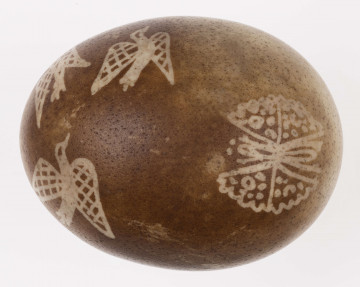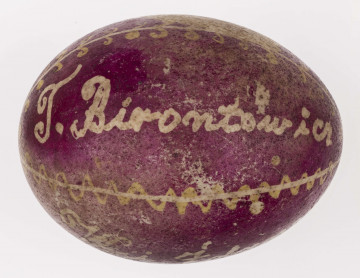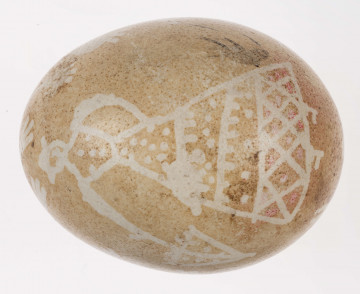
Easter egg
1901 — 1920
National Museum in Lublin
Part of the collection: Folk Art of the Lublin Region (17th–1st half of the 20th c.)
An Easter egg is an attribute of Easter, while an egg was a symbol of life, fertility, love and strength, and the symbolism of ornaments written on it played an important magical role. In the Lublin region, eggs were most often decorated using the batik technique, which involved writing a design with melted wax using a marker made of sheet metal in the form of a funnel, set on a stick (see also E/1117/ML).
According to the type of ornamentation, Lublin Easter eggs can be divided into two main groups: northern, where single-coloured patterns with straight lines predominate, and southern, with multicoloured and numerous volute ornaments (see E/1137/ML, E/1329/ML, E/1334/ML, E/1369/ML); in the central part of the Lublin region, the influences intermingled and multicoloured ornaments with straight lines occurred.
In the Lublin area, Easter eggs were dyed in onion decoction, usually obtaining a brown background in all shades up to black. The motif of flowers in a pot was particularly common on this background (see E/1038/ML). There were also figures of animals and people. Figures of girls and boys appeared in the adoration of the tree of life, in a dance parade or in genre scenes, for example, a musician by the river, a girl with a rake, a boy in a dovecote.
In the ethnographic collection of the National Museum in Lublin there are about 2500 Easter eggs made by artists from the Lublin region. Most were made in the years 1950-1980, but a significant proportion (around 500), unfortunately of unknown authorship, date from the early 20th century. This Easter egg is one of the oldest.
Author / creator
Dimensions
cały obiekt: height: 4,9 cm
Object type
Easter egg
Technique
batik
Material
wax, egg, plant-based pigment,
Creation time / dating
Creation / finding place
Owner
The National Museum in Lublin
Identification number
Location / status

1901 — 1920
National Museum in Lublin

1901 — 1920
National Museum in Lublin

1901 — 1920
National Museum in Lublin
DISCOVER this TOPIC
National Museum in Szczecin
DISCOVER this PATH
Educational path